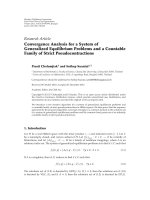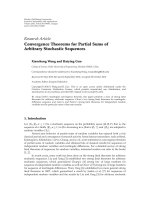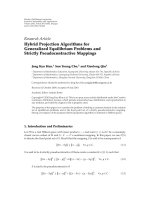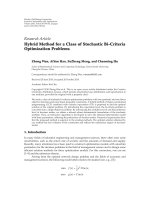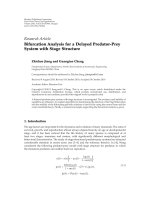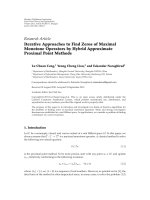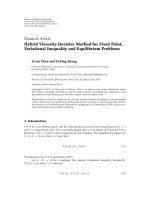Báo cáo hóa học: " Research Article Hybrid Method for a Class of Stochastic Bi-Criteria Optimization Problems" docx
Bạn đang xem bản rút gọn của tài liệu. Xem và tải ngay bản đầy đủ của tài liệu tại đây (483.64 KB, 12 trang )
Hindawi Publishing Corporation
Journal of Inequalities and Applications
Volume 2010, Article ID 745162, 12 pages
doi:10.1155/2010/745162
Research Article
Hybrid Method for a Class of Stochastic Bi-Criteria
Optimization Problems
Zhong Wan, AiYun Hao, FuZheng Meng, and Chaoming Hu
School of Mathematical Sciences and Computing Technology, Central South University,
Changsha, Hunan, China
Correspondence should be addressed to Zhong Wan,
Received 24 June 2010; Accepted 20 October 2010
Academic Editor: Kok Teo
Copyright q 2010 Zhong Wan et al. This is an open access article distributed under the Creative
Commons Attribution License, which permits unrestricted use, distribution, and reproduction in
any medium, provided the original work is properly cited.
We study a class of stochastic bi-criteria optimization problems with one quadratic and one linear
objective functions and some linear inequality constraints. A hybrid method of chance-constrained
programming CCP combined with variance expectation VE is proposed to find the optimal
solution of the original problem. By introducing the expectation level, the bi-criteria problem is
converted into a single-objective problem. By introducing the confidence level and the preference
level of decision maker, we obtain a relaxed robust deterministic formulation of the stochastic
problem. Then, an interactive algorithm is developed to solve the obtained deterministic model
with three parameters, reflecting the preferences of decision maker. Numerical experiments show
that the proposed method is superior to the existing methods. The optimal solution obtained by
our method has less violation of the constraints and reflects the satisfaction degree of decision-
maker.
1. Introduction
In many fields of industrial engineering and management sciences, there often exist some
uncertainties, such as the return rate of security and the amounts of demand and supply.
Recently, many attentions have been paid to construct optimization models with uncertain
parameters for the decision problems in the field of management science and to design some
efficient solution methods for these optimization models. For this connection, one can see
1–9 and the references therein.
Arising from the optimal network design problem and the fields of economic and
management sciences, the following model often needs to be studied see, e.g., 7:
min f
x
1
2
x
T
D
w
x,
max g
x
C
w
x
2 Journal of Inequalities and Applications
s.t.A
w
x ≥ b
w
,
x ≥ 0,
1.1
where f : R
n
→ R is continuously differentiable, w is a t-dimensional stochastic vector,
Cwc
1
w,c
2
w, ,c
n
w
T
and bwb
1
w,b
2
w, ,b
m
w
T
are given vectors,
Dwd
ij
w
n×n
and Awa
ij
w
m×n
are given stochastic matrices. So, Problem 1.1
is a stochastic bi-criteria optimization problem. The main difficulties to solve this kind of
problems lie in two aspects. The first one is that optimal decisions are required to be prior
to the observation of the stochastic parameters. In this situation, one can hardly find any
decision that has no constraints violation caused by unexpected random effects. The second
one is that no decision can optimize the two objective functions simultaneously.
By expectation method, the authors in 9 transformed P roblem 1.1 into the
following deterministic model:
min E
f
x
1
2
x
T
E
D
w
x,
max E
g
x
E
C
w
x
s.t.E
A
w
x ≥ E
b
w
,
x ≥ 0
1.2
and developed an algorithm to obtain an approximate solution of the original problem.
Though the expectation method is a convenient way of dealing with stochastic
programs 9, 10, it may not ensure that the optimal solution is robust as well as having
optimal values of objective functions in general. For this, we are going to propose a hybrid
method for the solution of Problem 1.1. The basic idea is as follows.
For the bi-criteria problem, we introduce a parameter of expectation level for the
second objective, and transform the original problem into a problem with single-objective
function. For the stochastic parameters, we introduce an appropriate combination of the
mean and variance of the cost, which is to be minimized subject to some chance constraints.
The variance appeared in the cost function can be interpreted as a risk measure, which can
make the solution more robust. For the chance constraint, it ensures that the probability
for the constraints to be satisfied is greater than or equal to some value. The larger this
value is taken, the higher probability the constraints are satisfied. In other words, the
chance constraints approach can guarantee that the obtained solution has less degree of
constraint violation see 4, 11. Based on such a reformulation for the original problem,
an interactive algorithm will also be developed to find its solution with some satisfaction
degree.
The remainder of this paper is organized as follows. In Section 2, we will deduce the
new robust deterministic formulation for the original stochastic model. Then, in Section 3,
an interactive algorithm will be developed to solve such a deterministic problem with three
Journal of Inequalities and Applications 3
parameters, reflecting the preferences of decision maker. Numerical experiments are carried
out in Section 4 to show the advantage of the proposed method. Final remarks are given in
the last section.
2. Reformulation of Stochastic Bi-Criteria Model by Hybrid Approach
In this section, we are going to reformulate the original stochastic bi-criteria problem into a
deterministic problem.
Note that there are various ways to deal with multiple-objective problems. For details,
see, for example, 6, 10, 12. In this paper, Problem 1.1 is converted into a single-objective
model by introducing a parameter, called the expectation level of decision maker.
Let ρ denote the expectation level of decision maker to the second objective. Then,
1.1 is relaxed into the f ollowing model:
min f
x
1
2
x
T
D
w
x
s.t.C
w
x ≥ ρ,
A
w
x ≥ b
w
,
x ≥ 0.
2.1
Notice that the solution of the above problem is a compromising solution of Problem 1.1
by a suitable ρ. Actually, ρ ≤ ρ
∗
, where ρ
∗
is the maximum of the second objective function.
When ρ ρ
∗
, the solution of 2.1 ensures that the second objective achieve its maximal value.
Next, taking into account that the expectation value represents the average level and
the variance indicates the deviation of the stochastic variable, the stochastic objective function
in 2.1 is transformed into
μE
1
2
x
T
D
w
x
1 − μ
σ
1
2
x
T
D
w
x
, 2.2
where E· and σ· denote, respectively, the expectation and the variance of stochastic matrix,
and μ ∈ 0, 1 is introduced to describe the preference of decision maker to the average level
and the robustness of objective value, and is called the preference level of decision maker. The
variance appeared in the cost function can be interpreted as the risk measure, which can make
the obtained solution more robust.
For the first stochastic inequality in 2.1, we introduce the so-called chance constraint
method to convert it into a deterministic inequality constraint, which is used to guarantee
that the stochastic constraint is satisfied with a probability as higher as possible.For the
4 Journal of Inequalities and Applications
general stochastic constraints Awx ≥ bw, we obtain their deterministic formulations by
expectation method as done in 9.
Specifically, Problem 2.1 is reformulated as
min μE
1
2
x
T
D
w
x
1 − μ
σ
1
2
x
T
D
w
x
s.t.P
n
i1
c
i
w
x
i
≥ ρ
≥ η,
E
A
w
x ≥ E
b
w
,
x ≥ 0,
0 ≤ μ ≤ 1,
2.3
where η is the probability (or confidence) level for the first stochastic constraint to be satisfied.
Denote Q and R, respectively, the expectation and the variance of the stochastic matrix
Dwd
ij
w
n×n
,thatis,
Q E
D
w
E
d
ij
w
n×n
,R σ
D
w
σ
d
ij
w
n×n
.
2.4
If all components of the stochastic matrix Dw are statistically independent, then, 2.3 reads
min
1
2
μx
T
Qx
1
4
1 − μ
x
2
T
Rx
2
s.t.P
n
i1
c
i
w
x
i
≥ ρ
≥ η,
E
A
w
x ≥ E
b
w
,
x ≥ 0,
0 ≤ μ ≤ 1,
2.5
where x
2
x
2
1
,x
2
2
, ,x
2
n
T
.
Journal of Inequalities and Applications 5
Furthermore, suppose that the probability density functions of all components of the
stochastic vector Cw are normally distributed, and are statistically independent, then, the
model 2.5 can be equivalently written as:
min
1
2
μx
T
Qx
1
4
1 − μ
x
2
T
Rx
2
s.t.P
n
i1
c
i
w
x
i
− M
N
<
ρ − M
N
≤ 1 − η,
n
j1
E
a
ij
w
x
j
≥ E
b
i
w
,i 1, 2, ,m,
x ≥ 0,
0 ≤ μ ≤ 1,
2.6
where M
n
i1
Ec
i
wx
i
, N
n
i1
σc
i
wx
2
i
.So,Model2.6 has the following
deterministic form:
min
1
2
μx
T
Qx
1
4
1 − μ
x
2
T
Rx
2
s.t.MΦ
−1
1 − η
N ≥ ρ,
n
j1
E
a
ij
w
x
j
≥ E
b
i
w
,i 1, 2, ,m,
x ≥ 0,
0 ≤ μ ≤ 1.
2.7
Denote
μ
ij
E
a
ij
,μ
i0
E
b
i
w
. 2.8
Then, 2.7 yields
min
1
2
μx
T
Qx
1
4
1 − μ
x
2
T
Rx
2
s.t.MΦ
−1
1 − η
N ≥ ρ,
n
j1
μ
ij
x
j
≥ μ
i0
,i 1, 2, ,m,
x ≥ 0,
0 ≤ μ ≤ 1,
2.9
6 Journal of Inequalities and Applications
where Φ
−1
is the inverse of the probability density function with standard normal
distribution.
From the above deduction, we obtain a new relaxed deterministic formulation 2.6 of
the original problem 1.1. Based on this model, an efficient solution method is developed in
the next section.
3. Interactive Algorithm
In this section, from Model 2.9, we are going to develop an interactive algorithm to
obtain an optimal solution of the original problem 1.1 such that there is less violation
of constraints. It is more robust in the sense of less degree of constraint violation taking
account of the satisfaction degree of decision maker. The basic idea of this algorithm
is to adjust the three-level parameters of decision maker until a satisfactory solution is
obtained.
It is noted that, for given μ, ρ,andη, we solve a subproblem that turns out to be
a minimization problem of quartic polynomial with one quadratical constraint and several
linear constraints 7. Then, by comparing the features of the solutions corresponding to a
series of subproblems, we decide whether or not the algorithm is to be terminated. The overall
algorithm is as follows.
Algorithm 3.1 Interactive Algorithm for Stochastic Bi-criteria Problems.
Step 1. Choose μ, ρ,andη, where 0 ≤ μ ≤ 1, ρ
min
≤ ρ ≤ ρ
max
, η
min
≤ η ≤ η
max
. Here, ρ
min
and
ρ
max
, η
min
and η
max
denote, respectively, the minimum and the maximum of ρ and η given by
the decision maker.
Let δ
1
, δ
2
,andδ
3
be three positive constant scalars, for example, fix δ
1
0.01, δ
2
0.5,
and δ
3
0.05. Take μ
0
0, ρ
0
ρ
min
,andη
0
η
min
.Seth 0, t 0, w 0, Δμ
t
Δη
h
Δρ
w
0.
Step 2. Compute a solution of the following subproblem:
min
1
2
μ
0
Δμ
t
x
T
Qx
1
4
1 − μ
0
− Δμ
t
x
2
T
Rx
2
s.t.MΦ
−1
1 − η
0
− Δη
h
N ≥ ρ
0
Δρ
w
,
n
j1
μ
ij
x
j
≥ μ
i0
,i 1, 2, ,m,
x ≥ 0,
0 ≤ μ ≤ 1.
3.1
The optimal solution is denoted by x
μρη
x
1
,x
2
, ,x
n
T
, the corresponding value of the
objective function is denoted by F
μρη
.LetΔη
h
Δη
h
δ
1
, h h 1.
Journal of Inequalities and Applications 7
Step 3. If η
0
Δη
h
>η
max
, then go to Step 5. Otherwise, go to Step 4.
Step 4. Ask the decision maker whether x
μρη
and F
μρη
are satisfactory. If they are, then go to
Step 9; Otherwise, ask the decision maker whether Δη
h
needs to be changed. If it does not,
then go to Step 2. Otherwise, ask the decision maker to update Δη
h
by Δη
h
,andgotoStep 2.
Step 5. Let Δρ
w
Δρ
w
δ
2
, w w 1, and Δη
h
0. If ρ
0
Δρ
w
>ρ
max
, then go to Step 7.
Otherwise, go to Step 6.
Step 6. Ask the decision maker whether Δρ
w
needs to be changed. If it does not, then go to
Step 2. Otherwise, update Δρ
w
by Δρ
w
,andgotoStep 2.
Step 7. Let Δμ
t
Δμ
t
δ
3
, t t 1, Δη
h
0, and Δρ
w
0. If μ
0
Δμ
t
> 1, the algorithm stops,
x
μρη
and F
μρη
are the desired results. Otherwise, go to Step 8.
Step 8. Ask the decision maker whether Δμ
t
needs to be changed. If it does not, then go to
Step 2. Otherwise, update Δμ
t
by Δμ
t
,andgotoStep 2.
Step 9. x
μρη
and F
μρη
are the desired results. The algorithm terminates.
4. Numerical Experiments
In this section, we will study the numerical performances of Algorithm 3.1. For this, suppose
that the probability density functions of all components of the stochastic vectors Cw and
bw, of the matrices Dw and Aw are normally distributed. These stochastic elements are
statistically independent, that is,
d
ij
w
∼ N
μ
ij
, σ
2
ij
,i,j 1, 2, ,n,
a
ij
w
∼ N
μ
ij
,σ
2
ij
,i 1, 2, ,m, j 1, 2, ,n,
b
i
w
∼ N
μ
i0
,σ
2
i0
,i 1, 2, ,m, c
i
w
∼ N
μ
i
,σ
2
i
,i 1, 2, ,n,
4.1
where Nμ, σ
2
denotes the normally distributed probability density function with mean μ
and variance σ
2
.
Firstly, we implement Algorithm 3.1 in Lingo 9.0 to investigate how the parameters
μ, ρ and η affect the optimal solution. Here, we take Awa
ij
w ∈ R
3×4
, bw ∈ R
3
,
Cw ∈ R
4
and Dwd
ij
w ∈ R
4×4
. For example, we take
a
11
w
∼ N
40, 94
2
,a
12
w
∼ N
25, 75
2
,
a
13
w
∼ N
31, 82
2
,a
14
w
∼ N
8, 21
2
,
a
21
w
∼ N
22, 61
2
,a
22
w
∼ N
38, 87
2
,
a
23
w
∼ N
21, 60
2
,a
24
w
∼ N
17, 48
2
,
8 Journal of Inequalities and Applications
a
31
w
∼ N
38, 86
2
,a
32
w
∼ N
28, 80
2
,
a
33
w
∼ N
17, 50
2
,a
34
w
∼ N
26, 74
2
,
b
1
w
∼ N
51, 120
2
,b
2
w
∼ N
32, 72
2
,
b
3
w
∼ N
43, 98
2
,c
1
w
∼ N
23, 64
2
,
c
2
w
∼ N
25, 74
2
,c
3
w
∼ N
19, 51
2
,
c
4
w
∼ N
27, 78
2
,d
11
w
∼ N
12, 31
2
,
d
12
w
∼ N
15, 41
2
,d
13
w
∼ N
10, 27
2
,
d
14
w
∼ N
17, 51
2
,d
21
w
∼ N
14, 43
2
,
d
22
w
∼ N
16, 43
2
,d
23
w
∼ N
13, 33
2
,
d
24
w
∼ N
15, 42
2
,d
31
w
∼ N
21, 59
2
,
d
32
w
∼ N
8, 19
2
,d
33
w
∼ N
11, 28
2
,
d
34
w
∼ N
20, 55
2
,d
41
w
∼ N
18, 55
2
,
d
42
w
∼ N
31, 84
2
,d
43
w
∼ N
32, 70
2
,d
44
w
∼ N
25, 83
2
,
μ 0.6,ρ 60,η 0.95. 4.2
Then, the subproblem in Algorithm 3.1 to be solved is as follows:
min 0.3x
T
Qx 0.1
x
2
T
Rx
2
s.t. 10622x
2
1
14283x
2
2
6720x
2
3
15835x
2
4
− 1150x
1
x
2
− 874x
1
x
3
− 1242x
1
x
4
− 950x
2
x
3
− 1350x
2
x
4
− 1026x
3
x
4
2760x
1
3000x
2
2280x
3
3240x
4
≥ 3600,
40x
1
25x
2
31x
3
8x
4
≥ 51,
22x
1
38x
2
21x
3
17x
4
≥ 32,
38x
1
28x
2
17x
3
26x
4
≥ 43,
x ≥ 0,
4.3
Journal of Inequalities and Applications 9
Ta b le 1: Effects of the three-level parameters on solutions.
μ,ρ,η xF
0.05, 160, 0.790.526, 1.249, 1.023, 0.221
T
2784.9
0.1, 137, 0.800.43, 1.053, 0.863, 0.181
T
1307.52
0.15, 150, 0.810.447, 1.128, 0.923, 0.187
T
1593.36
0.2, 139, 0.820.392, 1.024, 0.837, 0.163
T
997.7
0.25, 150, 0.830.627, 0.396, 0.504, 0.049
T
183.23
0.3, 140, 0.840.36, 0.995, 0.811, 0.149
T
755.5
0.35, 160, 0.850.388, 1.08, 0.902, 0.159
T
1057.28
0.4, 141, 0.860.323, 0.959, 0.778, 0.132
T
539.68
0.45, 165, 0.870.358, 1.094, 0.886, 0.145
T
823.29
0.5, 142, 0.880.289, 0.926, 0.748, 0.116
T
380.788
0.55, 210, 0.890.408, 1.326, 1.07, 0.165
T
1410.02
0.6, 200, 0.900.361, 1.23, 0.989, 0.144
T
914.41
0.65, 260, 0.910.442, 1.571, 1.279, 0.132
T
2058.31
0.7, 205, 0.921.701, 0.222, 0.168, 0.141
T
717.62
0.75, 225, 0.930.371, 1.276, 0.978, 0.125
T
635.42
0.8, 210, 0.940.263, 1.161, 0.911, 0.095
T
345.71
0.85, 245, 0.950.279, 1.313, 1.024, 0.098
T
418.55
0.9, 215, 0.961.3, 0.286, 0.049, 0.102
T
102.76
0.95, 246, 0.971.501, 0.182, 0.01, 0.052
T
83.44
0.95, 280, 0.980.324, 1.355, 0.155, 0.028
T
112.37
where
Q
⎛
⎜
⎜
⎜
⎜
⎜
⎝
12 15 10 17
14 16 13 15
21 8 11 20
18 31 32 25
⎞
⎟
⎟
⎟
⎟
⎟
⎠
,R
⎛
⎜
⎜
⎜
⎜
⎜
⎝
961 1681 729 2601
1849 1849 1089 1764
3481 361 784 3025
3025 7056 4900 6889
⎞
⎟
⎟
⎟
⎟
⎟
⎠
. 4.4
In Lingo 9.0, we obtain the optimal solution of Model 4.3: x
1
0.6398, x
2
0.3884,
x
3
0.4965, x
4
0.0381 and t he value of the objective function is 105.682. In the same setting,
from Model 1.2 in 9, we obtained an optimal solution x
01
2.52, x
02
x
03
x
04
0, and
f
0
x36.36, g
0
x44.31.
With different choices of the level parameters μ, ρ and η, it can be seen how these
parameters affect the optimal solution. The numerical results are reported in Table 1.
From Table 1, it can be seen that the adjustment of μ, ρ,andη is helpful for t he decision
maker to choose a favorite solution.
In the end of this section, we are going to investigate the degree of constraint violation
for the proposed method. By simulation, in MATLAB 6.5, 48 samples of all stochastic
parameters are generated. Thus, we get 48 optimization problems. Next, we are going to
investigate the degree of constraint violation for the proposed method in this paper and the
expectation method presented in 9.
Let x
1
and x
2
, respectively, denote the optimal solutions of the objective function from
the expectation model and the new hybrid model, while t1andt2 denote the violation degrees
10 Journal of Inequalities and Applications
Ta b le 2: Comparison between expectation method and hybrid method.
Samples x
1
t1 x
2
t2
1 0, 1.15, 0.63, 0
T
0 0.47, 0.43, 0.56, 0.03
T
0
2 1.02, 0, 0, 0.06
T
1 0.24, 0.34, 0.24, 0
T
0
3 1.917, 0, 0, 0
T
0 0.65, 0.39, 0.49, 0.04
T
0
4 1.917, 0, 0, 0
T
0 0.79, 0.33, 0.43, 0.04
T
0
5 1.1, 0, 0, 0
T
0 0.24, 0.34, 0.24, 0
T
0
6 1.917, 0, 0, 0
T
0 0.54, 0.42, 0.54, 0.03
T
0
7 0.96, 0, 0, 0.09
T
0 0.24, 0.34, 0.24, 0
T
0
8 1.917, 0, 0, 0
T
0 0.46, 0.43, 0.57, 0.03
T
0
9 0.78, 0, 0, 0.22
T
0 0.24, 0.34, 0.24, 0
T
0
10 1.917, 0, 0, 0
T
0 0.50, 0.43, 0.56, 0.03
T
00
11 1.917, 0, 0, 0
T
0 0.55, 0.42, 0.54, 0.03
T
0
12 0.88, 0, 0, 0.15
T
0 0.24, 0.34, 0.24, 0
T
0
13 1.126, 0, 0, 0
T
1 0.24, 0.34, 0.24, 0
T
0
14 1.917, 0, 0, 0
T
0 0.68, 0.37, 0.48, 0.04
T
0
15 0.939, 0, 0, 0.112
T
0 0.24, 0.34, 0.24, 0
T
0
16 1.917000
T
0 0.49, 0.43, 0.56, 0.03
T
0
17 0, 1.15, 0.63, 0
T
0 0.50, 0.43, 0.55, 0.03
T
0
18 0, 0.15, 0.63, 0
T
3 0.46, 0.44, 0.57, 0.03
T
0
19 0, 0.15, 0.63, 0
T
3 0.5, 0.43, 0.56, 0.03
T
0
20 0.49, 0, 0, 0.43
T
1 0.24, 0.34, 0.24, 0
T
0
21 0, 1.15, 0.63, 0
T
0 0.52, 0.42, 0.55, 0.03
T
0
22 0.94, 0, 0, 0.11
T
0 0.24, 0.34, 0.24, 0
T
0
23 1.917, 0, 0, 0
T
0 0.65, 0.38, 0.49, 0.04
T
0
24 1.917, 0, 0, 0
T
0 0.67, 0.38, 0.48, 0.04
T
0
25 1.917, 0, 0, 0
T
0 0.64, 0.39, 0.5, 0.04
T
0
26 1.31, 0.55, 0, 0
T
1 1.01, 0.54, 0.38, 0.07
T
0
27 0, 1.15, 0.63, 0
T
3 0.47, 0.43, 0.56, 0.03
T
0
28 1.11, 0, 0, 0
T
0 0.24, 0.34, 0.24, 0
T
0
29 1.917, 0, 0, 0
T
0 0.51, 0.43, 0.55, 0.03
T
0
30 1.917, 0, 0, 0
T
0 0.48, 0.43, 0.56, 0.03
T
0
31 0, 1.15, 0.63, 0
T
0 0.49, 0.43, 0.56, 0.03
T
0
32 1.917, 0, 0, 0
T
0 0.59, 0.25, 0.58, 0.13
T
0
33 1.917, 0, 0, 0
T
0 0.62, 0.4, 0.51, 0.04
T
0
34 1.917, 0, 0, 0
T
0 0.49, 0.43, 0.56, 0.03
T
0
35 1.917, 0, 0, 0
T
0 0.5, 0.43, 0.56, 0.03
T
0
36 2.08, 0.02, 0, 0
T
0 0.89, 0.34, 0.39, 0.06
T
0
37 2.28, 1.39, 0, 0
T
1 2.28, 1.39, 0, 0
T
0
38 1.57, 0.37, 0, 0
T
0 0.87, 0.52, 0.17, 0.12
T
0
39 1.08, 0, 0, 0.01
T
0 0.24, 0.34, 0.24, 0
T
0
40 1.96, 0, 0, 0
T
1 0.89, 0.30, 0.39, 0.05
T
0
41 1.917, 0, 0, 0
T
0 0.58, 0.41, 0.52, 0.04
T
0
42 0, 1.15, 0.63, 0
T
0 0.53, 0.42, 0.54, 0.03
T
0
43 1.917, 0, 0, 0
T
0 0.46, 0.44, 0.57, 0.03
T
0
44 1.42, 0.79, 0, 0
T
0 1.33, 0.8, 0.25, 0.04
T
0
45 1.917, 0, 0, 0
T
0 0.49, 0.43, 0.56, 0.03
T
0
46 1.917, 0, 0, 0
T
0 0.48, 0.43, 0.56, 0.03
T
0
47 0, 0.15, 0.63, 0
T
3 0.48, 0.43, 0.56, 0.03
T
0
48 0.93, 0, 0, 0.12
T
1 0.24, 0.34, 0.24, 0
T
00
Journal of Inequalities and Applications 11
against all constraints of the expectation model and the hybrid model, respectively. Take μ
0.6, ρ 60, and η 0.95. Table 2 reports the numerical results.
From Table 2, it is shown that the optimal solution by the hybrid method has no
violation of the constraints for all the 48 samples with 0.95 probability level, while there are
19 times of violating constraints for the expectation method.
5. Final Remarks
In this paper, a class of stochastic bi-criteria optimization problems was studied by a new
hybrid method where the chance-constrained programming CCP is combined with the
variance-expectation VE method. Then an interactive algorithm was developed to find an
optimal solution of the original problem, reflecting the satisfaction degree of the decision
maker.
Following the proposed hybrid method, if we deal with all the stochastic inequalities
by the chance constraint method, then the optimal solution would have less constraints
violation degree than that obtained by the method proposed in this paper. But in this
situation, a joint chance constraint is generated as follows:
P
n
i1
c
i
w
x
i
≥ ρ, A
w
x ≥ b
w
≥ η.
5.1
Even if some strong assumptions are imposed, it is difficult to obtain explicit expressions of
deterministic inequalities constraints that are involved only with t he decision variable x ∈
R
n
for the stochastic constraints. Thus, it calls for the investigation of other more efficient
approaches.
Acknowledgments
The authors would like to express their thanks to the two anonymous referees for their
comments on the paper, which have improved its presentation. The work of these authors
was supported by the National Natural Science Foundation of China Grant no. 71071162,
and 70921001 and the Project for Excellent Talent of New Century, Ministry of Education,
China Grant no. NCET-07-0864.
References
1 D. Kofja
ˇ
c, M. Kljaji
´
c, and V. Rejec, “The anticipative concept in warehouse optimization using
simulation in an uncertain environment,” European Journal of Operational Research, vol. 193, no. 3, pp.
660–669, 2009.
2 P. B. Hermanns and N. V. Thoai, “Global optimization algorithm for solving bilevel programming
problems with quadratic lower levels,” Journal of Industrial and Management Optimization,vol.6,no.1,
pp. 177–196, 2010.
3 C. Jiang, X. Han, G. R. Liu, and G. P. Liu, “A nonlinear interval number programming method for
uncertain optimization problems,” European Journal of Operational Research, vol. 188, no. 1, pp. 1–13,
2008.
4 B. D. Liu, L.Q. Zhao, and G. Wang, Uncertainty Programs and Its Applications, TsingHua University,
Beijing, Germany, 2003.
12 Journal of Inequalities and Applications
5 M. J. Pardo and D. de la Fuente, “Design of a fuzzy finite capacity queuing model based on the degree
of customer satisfaction: analysis and fuzzy optimization,” Fuzzy Sets and Systems, vol. 159, no. 24, pp.
3313–3332, 2008.
6 D. Panda, S. Kar, and M. Maiti, “Multi-item EOQ model with hybrid cost parameters under
fuzzy/fuzzy-stochastic resource constraints: a geometric programming approach,” Computers &
Mathematics with Applications, vol. 56, no. 11, pp. 2970–2985, 2008.
7 Z. Wan, A Y. Hao, F Z. Meng, and Y L. Wang, “Interactive algorithms for optimization to multiple-
objectives design problems with stochastic environment,” Journal of Hunan University Natural Sciences,
vol. 37, no. 8, pp. 83–86, 2010.
8 Z. Wan, S. Zhang, and Y. Wang, “Penalty algorithm based on conjugate gradient method for solving
portfolio management problem,” Journal of Inequalities and Applications, vol. 2009, Article ID 970723,
16 pages, 2009.
9 J. Xu and J. Li, “A class of stochastic optimization problems with one quadratic and several linear
objective functions and extended portfolio selection model,” Journal of Computational and Applied
Mathematics, vol. 146, no. 1, pp. 99–113, 2002.
10 K. Maity and M. Maiti, “A numerical approach to a multi-objective optimal inventory control problem
for deteriorating multi-items under fuzzy inflation and discounting,” Computers & Mathematics with
Applications, vol. 55, no. 8, pp. 1794–1807, 2008.
11 P. Kall and S. W. Wallace, Stochastic Programming, Wiley-Interscience Series in Systems and
Optimization, John Wiley & Sons, Chichester, UK, 1994.
12 K. Pekka and G. Yu, “A reference direction approach to multiple objective quadratic-linear
programming,” European Journal of Operational Research, vol. 102, no. 3, pp. 601–610, 1997.
